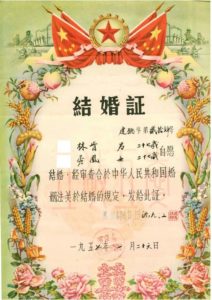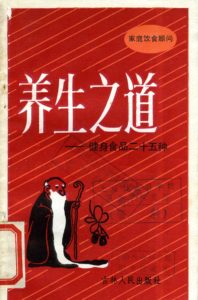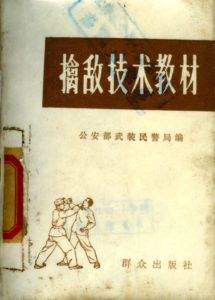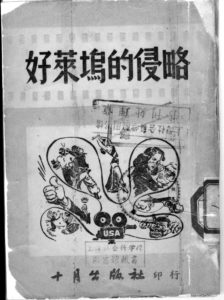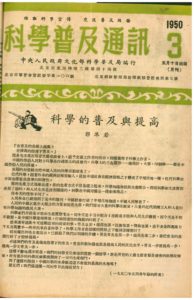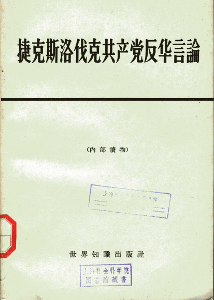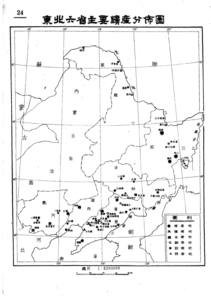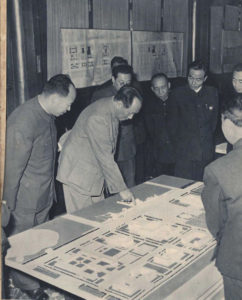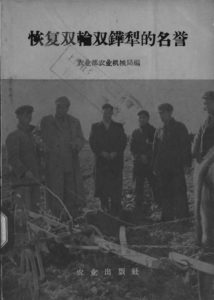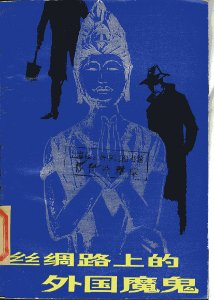Gems of the Collection
What is a Text?
Inspired by my colleagues who started in 2014 the wonderful website prchistory.org where Michael Schoenhals presents a Document of the Month offering access to unknown details of PRC history this website introduces gems taken from the SASS Collection at the University of Erlangen-Nuremberg. This collection covers the book production of the People’s Republic of China and was donated by the Shanghai Academy of Social Sciences (SASS) to our Institute of Sinology. Read more…
Do not fear the atomic bomb! (1958)
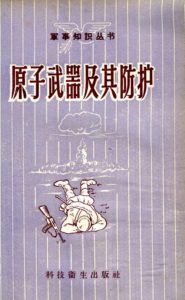 The dropping of the atomic bombs over Hiroshima and Nagasaki in August 1945 changed the world forever (or at least for a long time). Not only did the event end the Second World War in the Pacific. It drove home the horrors of nuclear weapons and set the stage for one of the most central issues of the emerging Cold War: the nuclear arms race. The explosion of the bombs in Japan worried the Soviet Union. The country already had its own nuclear program, but it would only possess its own a-bomb in 1949. The reason was that the SU had begun research on nuclear weapons in earnest only one and a half years after the United States, in October 1942 (the origins of the Manhattan Project went back to February 1940) (Craig and Radchenko 2008, 4, 50). Read more…
The dropping of the atomic bombs over Hiroshima and Nagasaki in August 1945 changed the world forever (or at least for a long time). Not only did the event end the Second World War in the Pacific. It drove home the horrors of nuclear weapons and set the stage for one of the most central issues of the emerging Cold War: the nuclear arms race. The explosion of the bombs in Japan worried the Soviet Union. The country already had its own nuclear program, but it would only possess its own a-bomb in 1949. The reason was that the SU had begun research on nuclear weapons in earnest only one and a half years after the United States, in October 1942 (the origins of the Manhattan Project went back to February 1940) (Craig and Radchenko 2008, 4, 50). Read more…
Hujing hu’ai 互敬互爱 (1957)
On the occasion of the upcoming colorful and joyous Christmas the text of this month features an occasional found on a flea market in Nanjing in 2013, a marriage certificate. The first one handed out to the husband in no way differs from the one of the wife (except the order of names). The fact that Nanjing city authorities already issued two copies of the same marriage certificate shows that by the year 1957 gender equality was already recognized by state authorities, after all the imprint in the middle reads hujing hu’ai 互敬互爱, or „Respect each other, love each other“, fashioning romance in a socialist sense. Read more…
Slide Shows as Medium of Education (1950s)
From the early years of the PRC the dissemination of both science and ideology relied on slide shows (tu huandeng 土幻灯) that were considered adequate means of communicating knowledge to illiterate peasants and workers. The Newsletter of Science Dissemination (Kexue puji tongxun 科学普及通讯) that started publication in 1950 emphasizes the efficiency of slide shows in communicating, especially when pictures or drawings replaced text. Read more…
Jiankangbao 健康报 (since 1931)
Issued by the Weishengbu 卫生部
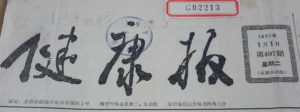 The Jiankangbao (JKB) is an official mouthpiece of the Weishengbu, the ministry of health, and thus the CCP, featuring official directives, announcements and articles formerly published in the Renmin ribao 人民日报 (RMRB) as well as articles on hygiene, health and medical topics. Read more…
The Jiankangbao (JKB) is an official mouthpiece of the Weishengbu, the ministry of health, and thus the CCP, featuring official directives, announcements and articles formerly published in the Renmin ribao 人民日报 (RMRB) as well as articles on hygiene, health and medical topics. Read more…
Artifacts of the Revolution (1976)
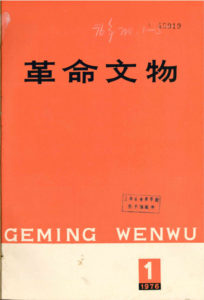 The periodical Artifacts of the Revolution (Geming wenwu 革命文物) was a bimonthly publication starting to appear in April 1976. It was a declared project of Hua Guofeng 华国锋 who at that time was struggling with Jiang Qing 江青 and the Gang of Four 四人帮 on the question who should be considered the true successor of Mao Zedong 毛泽东. After the death of Zhou Enlai 周恩来 on January 8, 1976 Hua had taken over the post as acting Premier of the PRC and as the First Vice Chairman of the Communist Party of China. He regarded himself as the legitimate successor to the Great Chairman, yet had to justify this claim, which he did by presenting a ‘testament’ in Mao’s handwriting that also included the most famous saying that reproduced by Hua again and again at that time, namely “With you in charge, I’m at ease” (Ni banshi, wo fangxin 你办事我放心). Read more…
The periodical Artifacts of the Revolution (Geming wenwu 革命文物) was a bimonthly publication starting to appear in April 1976. It was a declared project of Hua Guofeng 华国锋 who at that time was struggling with Jiang Qing 江青 and the Gang of Four 四人帮 on the question who should be considered the true successor of Mao Zedong 毛泽东. After the death of Zhou Enlai 周恩来 on January 8, 1976 Hua had taken over the post as acting Premier of the PRC and as the First Vice Chairman of the Communist Party of China. He regarded himself as the legitimate successor to the Great Chairman, yet had to justify this claim, which he did by presenting a ‘testament’ in Mao’s handwriting that also included the most famous saying that reproduced by Hua again and again at that time, namely “With you in charge, I’m at ease” (Ni banshi, wo fangxin 你办事我放心). Read more…
The Way to Nourishing Life – 25 Healthy Foods (1982)
The small booklet „The Way to Nourishing Life“ (Yangsheng zhi dao 养生之道), published by the Guilin Renmin Chubanshe 桂林人民出版社 in 1982, is part of a five-book-series that was translated from Japanese into Chinese as the Japanese nutrition science was deemed more advanced than the Chinese in the beginning of the 1980s. In this particular publication 25 healthy foods or eating methods are explained in detail, some entries are enhanced by tables about the nutritional value. The intention of this book is to clear up misunderstandings in the population on food hygiene and nutritional needs with scientific arguments. The scientificity of eating and drinking is stressed frequently, showing the need to base the author’s arguments in a well-established system. Read more…
Electrostatic Accelerators for Peasants (1959)
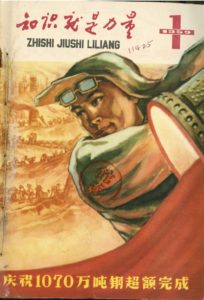 In 1956 a new journal dedicated to the dissemination of science appeared, entitled Knowledge Is Power (Zhishi jiushi liliang 知识就是力量, 1956-62). The title referred to the famous saying by Francis Bacon (1561-1626), that is “knowledge itself is power” (ipsa scientia potentia est). It is not surprising that this saying enjoyed greatest popularity during Maoist times. The namesake of this Chinese journal was a Soviet journal on popular science that had installed Bacon’s slogan as a generally shared idea in socialist countries and shaped the consciousness of the new working class. It followed the style and ideas of its Soviet namesake Знание-сила, presented the vision of “tomorrow” – the near future – for young workers and students of polytechnic secondary schools. Its aim was to place production and dissemination of knowledge in the hands of the working people. Read more…
In 1956 a new journal dedicated to the dissemination of science appeared, entitled Knowledge Is Power (Zhishi jiushi liliang 知识就是力量, 1956-62). The title referred to the famous saying by Francis Bacon (1561-1626), that is “knowledge itself is power” (ipsa scientia potentia est). It is not surprising that this saying enjoyed greatest popularity during Maoist times. The namesake of this Chinese journal was a Soviet journal on popular science that had installed Bacon’s slogan as a generally shared idea in socialist countries and shaped the consciousness of the new working class. It followed the style and ideas of its Soviet namesake Знание-сила, presented the vision of “tomorrow” – the near future – for young workers and students of polytechnic secondary schools. Its aim was to place production and dissemination of knowledge in the hands of the working people. Read more…
Teaching Material of Skills for Capturing the Enemy (1979)
Teaching Material of Skills for Capturing the Enemy (Qindi jishu jiaocai 擒敌技术教材), published by Office of Armed Civil Police Forces at the Ministry of Public Security (Gonganbu wuzhuang minjingju 公安部武装民警局), 1979, Qunzhong chubanshe.
This concise booklet—published in 1979 after the fall of the Gang of Four—contains various exercises and training skills for police officers, providing them with the necessary combat techniques to fight agains criminals and bad elements in society. Read more…
The Invasion by Hollywood (1951)
The small booklet Invasion by Hollywood (Haolaiwu de qinlüe 好萊塢的侵略) is a 1951 publication by the Shiyue chubanshe 十月出版社. It is a collection of articles denouncing movies and the American influence on movies previously published in different journals. The collection mainly consists of newspaper articles by David Piatt, an American communist film critic, which were translated from English into an abridged Chinese version by readers of the New York Labour Times, but also of some texts contributed by Chinese authors. Read more…
Bringing Movies to the Countryside (1950)
The use of cinema in China was a powerful weapon of propaganda in the modernization process in 20th century China. A true breakthrough occurred in the year 1949 when film production and distribution came under state control, with politics and art closely intertwined.
In fact, the CCP’s interest and penetration into the movie industry had already started during its conflict with Japan and KMT. After the Communist triumph in mainland China, the whole industry was soon under the complete control of the Party. Not only did the CCP establish the strict centralized administration of cinema, the newborn regime also imposed direct management on both movie production process and distribution-exhibition affairs. Read more…
Anti-Chinese Propaganda by the Czechoslovakian Communist Party (1965)
This book, entitled The Anti-Chinese Propaganda aired by the Czechoslovakian Communist Party (Jiekesiluofake Gongchandang fan-Hua yanlun 捷克斯洛伐克共产党反华言论, 1965) offers a detailed insight into the deep feeling of insecurity in the People’s Republic of China which was caused by the reshuffling of the geopolitical situation in the early 1960s that in the end led to the irreconcilable split between the two global powers in communism, the Soviet Union and China. Read more…
Resisting America and Aiding Korea in Early 1950s Exhibitions - the case of the 抗美援朝运动中的东北与朝鲜图集 (1951)
Shortly after the founding of the People’s Republic the Chinese Communist Party soon faced existential problems caused by geopolitical shifts in the East Asian region. The outbreak of the Korean War in June 1950 — since then largely seen as a proxy war — was not only seen as a war concerning the rivaling forces on the Korean peninsula, but one where the great powers tested their strength, with certainly Korea and probably China becoming the victim of the conflict. When the new government in Beijing engaged in propagating its ideology on a nation-wide scale in 1949 it was not only the fight for hygiene and the dissemination of technological and technical knowledge that was communicated, but also knowledge on the global situation that should make the Chinese people vigilant. Read more…
Gazetteer of Extraordinary Output (1957)
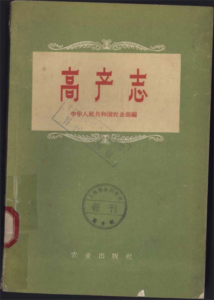 1957 was remarkable in terms of the drastic influence that its happenings would cast on Chinese politics and economy. It was the year of Rectification Campaign [整风], and Anti-Rightist Movement [反右]. And the same year also witnessed the inauguration of the second Five-Year Plan [五年计划], which would eventually lead Chinese economy into a disastrous journey, widely known as the Great Leap Forward [大跃进]. The initiative of such movement started to take form around the conclusion of a nationwide debate over the official line of development between the radicals and the moderates within the Party. As the result, Mao Zedong, who had grown increasing dissatisfied with his perceived conservativism [保守主义], decided to curb the illness of “opposing incautious advance” [反冒进] in economic area. Read more…
1957 was remarkable in terms of the drastic influence that its happenings would cast on Chinese politics and economy. It was the year of Rectification Campaign [整风], and Anti-Rightist Movement [反右]. And the same year also witnessed the inauguration of the second Five-Year Plan [五年计划], which would eventually lead Chinese economy into a disastrous journey, widely known as the Great Leap Forward [大跃进]. The initiative of such movement started to take form around the conclusion of a nationwide debate over the official line of development between the radicals and the moderates within the Party. As the result, Mao Zedong, who had grown increasing dissatisfied with his perceived conservativism [保守主义], decided to curb the illness of “opposing incautious advance” [反冒进] in economic area. Read more…
A Decade of Socialist Architecture, 1949-1959
The entanglement between power and architecture is a phenomenon which may be as old as human society itself. Architecture is able to function as one of the most common vehicles of power not only because of the symbolic and awe-inspiring effects that it activates through its products. Furthermore, the acts to design, plan, and construct buildings are part of the general way that power operates in occupying landscape and controlling the human body spatially. Read more…
Why Did A Plough Matter? (1958)
“Do you support adopting two-wheeled, doubled-share plough [双轮双铧犁]?”
Imagine that you were a Chinese farmer earning a living during the late-1950s, and not showing positive attitude to this question; then you might be well running the risk of being labeled as a person of conservative thought [保守思想] or, even worse, a rightist [右派分子]. Read more…
Foreign Devils on the Silk Road (1982)
Peter Hopkirk (1982): Sichoulu shang de waiguo mogui 丝绸路上的外国魔鬼. Lanzhou: Gansu renmin chubanshe.
This book is a translation of Peter Hopkirk’s book Foreign Devils on the Silk Road: The Search for the Lost Cities and Treasures of Chinese Central Asia (1980). Hopkirk (1930-2014), a British journalist who had traveled widely through Central Asia, India and China, describes in it the rediscovery of the Silk Road by scholars and adventurers in the beginning of the 20th century, amongst them Sven Hedin, Aurel Stein, Paul Pelliot and Langdon Warner (the latter became one of the models for Steven Spielberg’s Indiana Jones). Read more…
